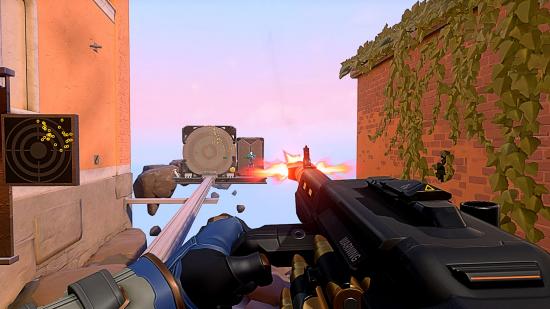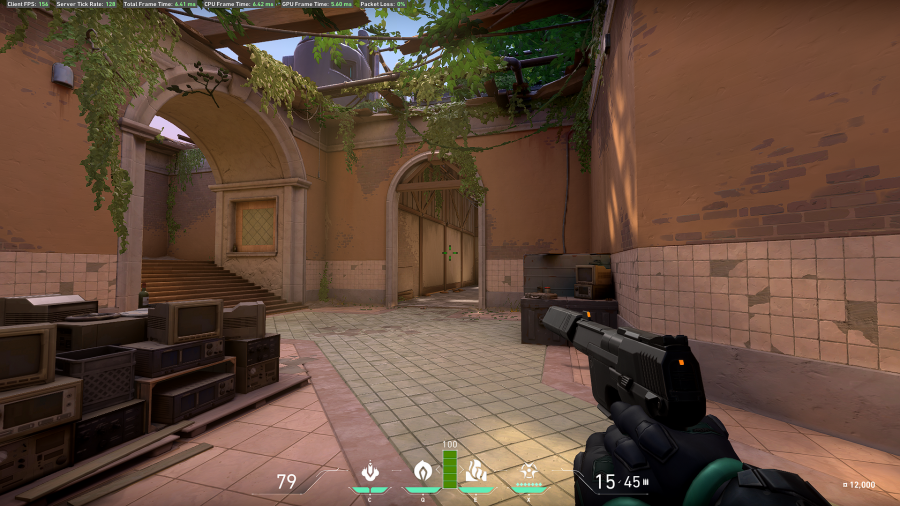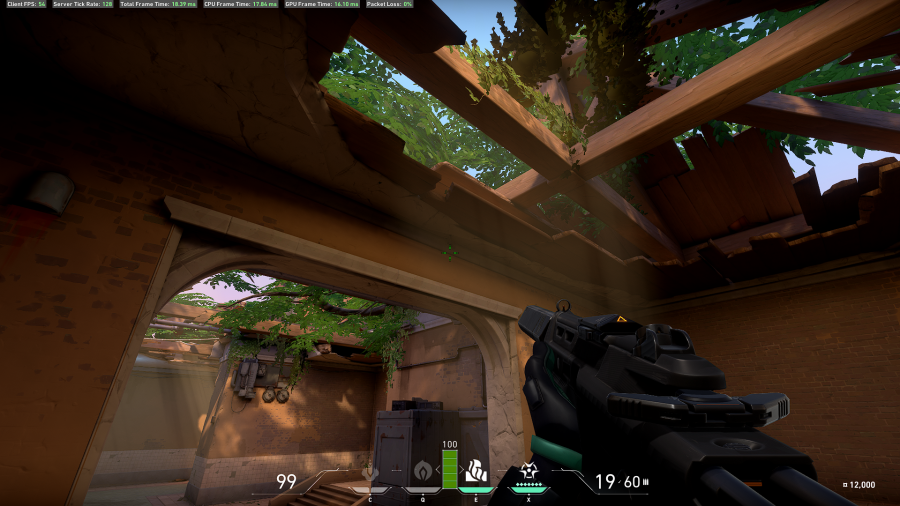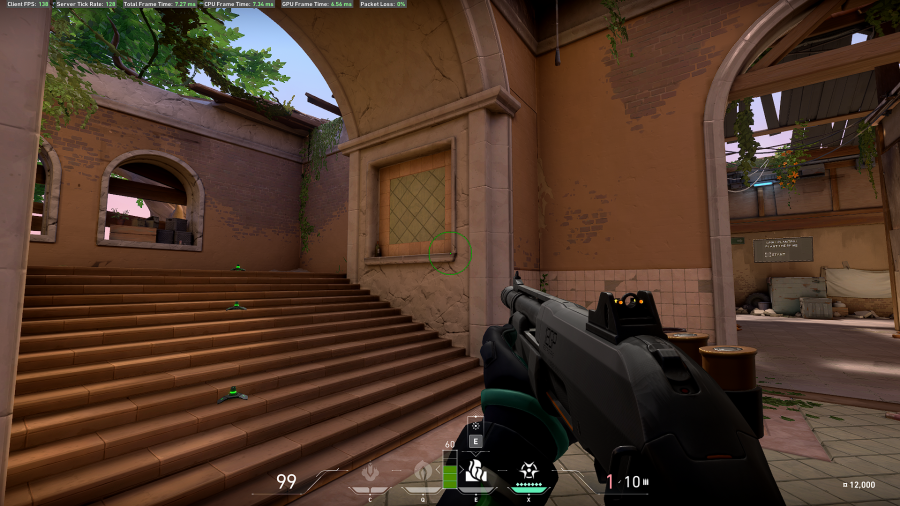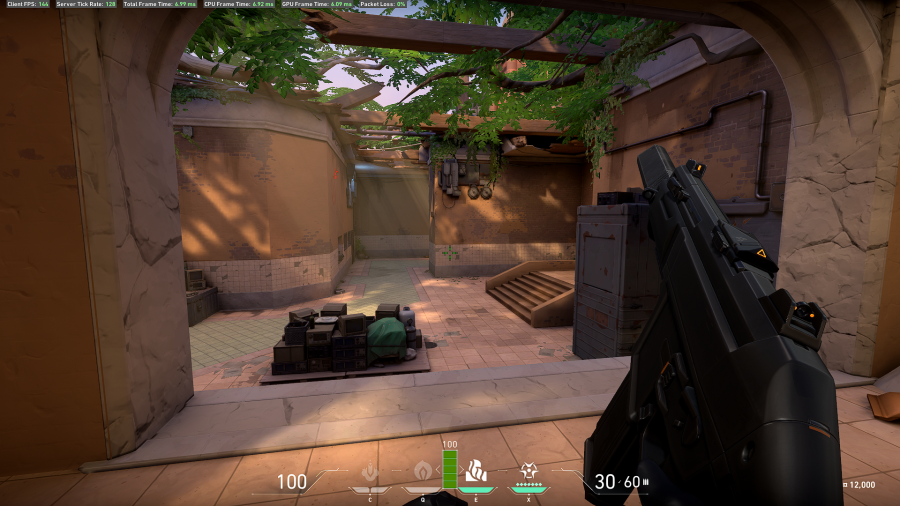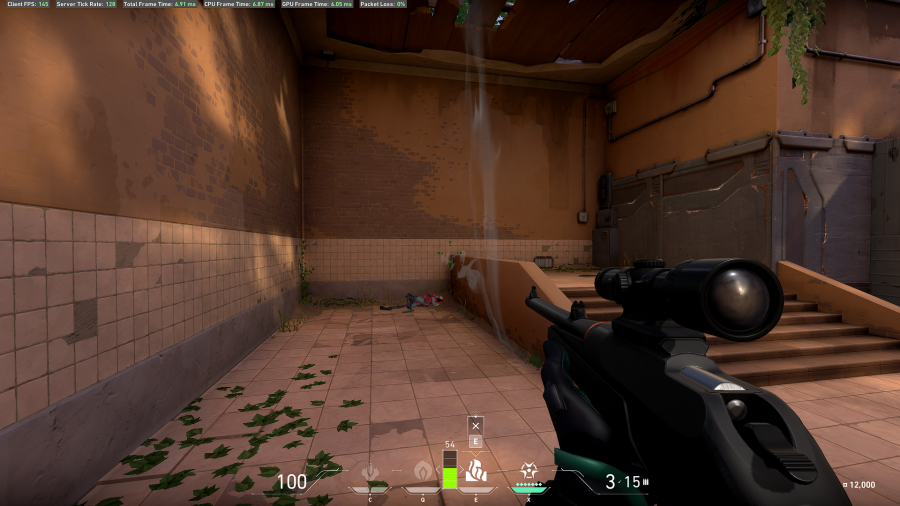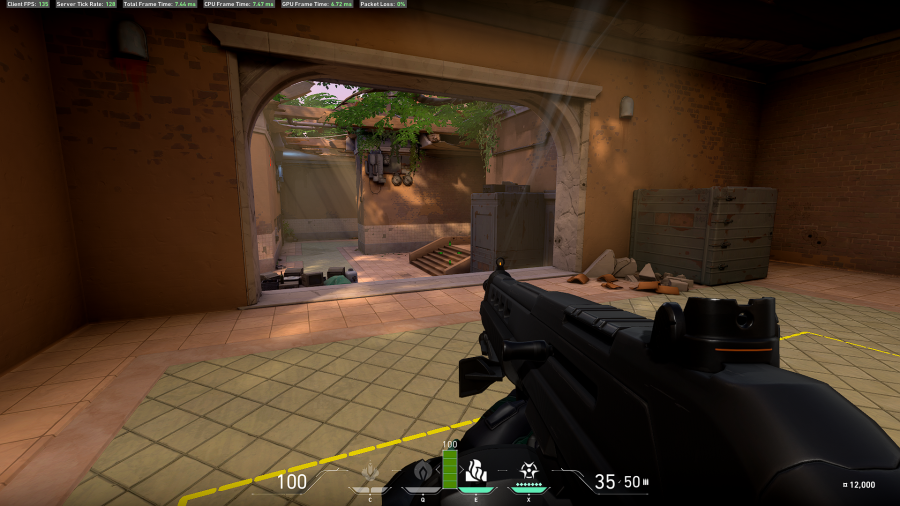Looking for a list of the best Valorant guns and how to use them? We’ve spent countless hours playing Riot’s tactical FPS game, and we’ve got some solid Valorant weapon recommendations to pass on. Keep in mind that the best Valorant weapon always depends on your current situation – use this list as a guideline to help inform your buying decisions.
All aboard the Valorant hype train. Riot Games has taken a fresh approach to its multiplayer first-person shooter by leaning heavily into its competitive credentials. So it makes sense that the studio bases so much of their game – especially the weapon behaviour – off two of the best competitive shooters around: CS:GO and its predecessor Counter-Strike.
It’s clear that many of the weapons in Valorant have a CS equivalent, but there are some key differences to all of them, and if you’ve never played a CS-style shooter then there’s a good chance they’ll all feel alien to you. Either way, we’ve put them all to the test in order to bring you a tier list of Valorant guns, as well as some tips for handling each one so you can master your favourites.
If there’s a particular Valorant gun you’re interested in then here is a list you can jump through of all Valorant weapons:
Valorant sidearms
Getting good with pistols is key in Valorant as they all boast the potential to earn you good money during an eco round. Unlike in many FPS games, a decent pistol player can outgun a rifler all day long if their aim is on point.
Classic
- Primary fire:
- Semi-automatic
- 6.75 rounds/second
- Alt. fire:
- 3-round burst, spread increase
- 2.22 rounds/second
- Mag capacity: 12
- Wall penetration: low
This is the default pistol you’ll spawn every round with. It does low damage but like anything, will net you a kill if you stick the crosshairs on an enemy’s head and land a couple of shots. It’s pretty accurate and the alternate fire mode can be handy for strafing around a corner and landing a decent amount of damage. The Classic is so powerful that it makes a lot of the weapons in Valorant feel weak in comparison – the best Valorant players typically keep the Classic rather than investing in weapons like shotguns.
Shorty
Cost: 150
- Primary fire:
- Semi-automatic
- 3.3 rounds/second
- Alt. fire:
- N/A
- Mag capacity: 2
- Wall penetration: low
The Shorty is a bit of a gamble, but definitely has a role to fulfill on low-economy rounds, or even later on for holding certain positions. Land the majority of pellets and you can down any opponent in close-quarters with two shots – only one is needed if they’re unarmoured. If defending, the Shorty can be a great tool for holding key corners during the pistol rounds. Alternatively, if you’ve got a sniper later on and aren’t confident with it in short-range scraps then this is a cheap and effective backup.
Frenzy
Cost: 450
- Primary fire:
- Full-automatic
- 10 rounds/second
- Alt. fire:
- N/A
- Mag capacity: 13
- Wall penetration: low
This is tricky to control but a solid eco round weapon if you can reign in the sideways recoil. It deals the same damage per shot as the Classic, but if you can land a full spray with this then your Classic-toting counterpart will go down much faster. We recommend firing this in short bursts as the first four shots are highly accurate.
Ghost
Cost: 500
- Primary fire:
- Semi-automatic
- 6.75 rounds/second
- Alt. fire:
- N/A
- Mag capacity: 15
- Wall penetration: medium
CS players will recognise this as the silenced USP and it behaves almost identically. Tap fire results in perfect accuracy, making this a great sniper for pistol rounds. Suppressors don’t seem essential, but it makes it surprisingly difficult to ascertain exactly where the shot came from – and in a game where precision is everything that can win you a 1v1.
Sheriff
Cost: 800
- Primary fire:
- Semi-automatic
- 4 rounds/second
- Alt. fire:
- N/A
- Mag capacity: 6
- Wall penetration: high
If the Ghost is the USP from CS, then the Sheriff is the Deagle. One headshot is enough to kill up to 30 metres, even on an armoured opponent, however you have to be very patient with your shots otherwise you’ll find the Sheriff very tricky to use. If you’re a good shot then this is a brilliant weapon for an economy round.
Valorant SMGs
Not only are SMGs cheap and thus a useful primary for soft-eco builds, they also don’t suffer as much of a movement penalty as rifles, so can be great for aggressive pushes and short-range battles. If you’re not used to CS shooters then you may find that these are the easiest weapons to use as you can move relatively freely with them.
Stinger
Cost: 950
- Primary fire:
- Full-automatic
- 18 rounds/second
- Alt. fire:
- Zoom mode (1.15x) 4-round burst, spread reduction
- 4 rounds/second
- Mag capacity: 20
- Wall penetration: low
The Stinger is a cheap SMG for eco rounds, but a surprisingly versatile one with its alt-fire allowing very accurate shots over long-ranges. If you can hit heads then you’ll find this can get you kills at any stage of the game. The recoil is surprisingly friendly, too – we find that you can get around with 8 shots before having to significantly readjust your aim.
Spectre
Cost: 1600
- Primary fire:
- Full-automatic
- 13.33 rounds/second
- Alt. fire:
- Zoom mode (1.15x), spread reduction
- 12 rounds/second
- Mag capacity: 30
- Wall penetration: medium
A little more expensive but a lot more accurate with plenty of spare potential. The Spectre shoots slightly slower, but as a result you can use it comfortably up to 30 metres. It also deals significantly more headshot damage than the Stinger you really want to be aiming for a 3-round burst onto your opponent’s head for a quick frag.
Valorant shotguns
Shotguns definitely have a place in Valorant, but you’ll want to have a clear idea of where you want to hold or how the team is going to push before selecting one of these close-quarters monsters in the buy menu.
Bucky
Cost: 850
- Primary fire:
- Semi-automatic
- 1.1 rounds/second
- Alt. fire:
- Semi-automatic Air Burst (extends range and accuracy of shot)
- 1.1 rounds/second
- Mag capacity: 5
- Wall penetration: low
The Bucky is cheap and can one-shot an unarmoured foe within ten metres even if you’re aiming at the body. That’s a lot of potential stopping power if you deploy it correctly, and if you’re a good shot then the Air Burst alternate fire mode can extend that one-shot range to 15 metres with a shot to the groin or neck.
Judge
Cost: 1650
- Primary fire:
- Full-automatic
- 3.5 rounds/second
- Alt. fire:
- N/A
- Mag capacity: 7
- Wall penetration: medium
Aim for the neck and this full-auto shotty will down in one shot within 10 metres. The fact that you can follow that up with six more shots in quick succession before reloading makes this a surprisingly good clutch weapon. We tend to use this to hold key chokepoints like the bathrooms on Bind.
Valorant rifles
These are the bread and butter of Valorant, and getting used to the shot timing, recoil, and handling of this weapon class will determine how well you fare. With almost all of these weapons boasting a guaranteed one-shot kill to the head at any practical range, it’s no surprise that good aimers tend to favour this class.
Bulldog
Cost: 2050
- Primary fire:
- Full-automatic
- 9.15 rounds/second
- Alt. fire:
- Zoom mode (1.25x), 3-round burst
- 4 rounds/second
- Mag capacity: 24
- Wall penetration: medium
You’ll need two headshots to kill with the Bulldog, but its low price and high body damage make it great for soft-eco builds. There is some nasty horizontal recoil that comes into play after your first 4 shots, so this is only truly effective just past 20 metres. Switch to the alt fire and a full burst landed to the chest will net you a kill, so it’s certainly not useless over long distances.
Guardian
Cost: 2250
- Primary fire:
- Semi-automatic
- 6.5 rounds/second
- Alt. fire:
- Zoom mode (1.5x), slight spread reduction
- 6.5 rounds/second
- Mag capacity: 12
- Wall penetration: medium
One for the tap-fire aim gods, the Guardian is always a one-hit kill to the head and is highly accurate so long as you don’t spam it. This rifle is probably the easiest weapon to use if you’re not used to CS aim as it removes the option of going full-auto and teaches you to tap-fire.
Phantom
Cost: 2900
- Primary fire:
- Full-automatic
- 11 rounds/second
- Alt. fire:
- Zoom mode (1.25x), slight spread reduction
- 9.9 rounds/second
- Mag capacity: 30
- Wall penetration: medium
This is very similar to the M4 from CS than any other rifle here – incredibly accurate even when going full-auto. Short, small bursts to the chest or head are all you need for a kill, and being able to quickly switch between engagements without having to wait for your recoil to reset makes this a very clutch-friendly rifle.
Vandal
Cost: 2900
- Primary fire:
- Full-automatic
- 9.25 rounds/second
- Alt. fire:
- Zoom mode (1.25x), slight spread reduction
- 8.32 rounds/second
- Mag capacity: 25
- Wall penetration: high
Valorant’s equivalent of the AK, the Vandal is picked for its ability to kill with a single headshot, which is great if your aim is up to it. If you’re not that confident however, then you may find this a very tough assault rifle to use. If you’re using at beyond 30 metres then you pretty much have to hit the enemy’s head to secure a quick kill, while you’ll still need decent aim to clean up with body shot kills at medium distances.
Valorant snipers
It takes a lot of practice to get good with Valorant snipers in close-quarters, but anyone should be able to get the hang of them when holding long angles – scope in, aim for the head, pull the trigger.
Marshal
Cost: 950
- Primary fire:
- Semi-automatic
- 1.5 rounds/second
- Alt. fire:
- Zoom mode (2.5x), slight spread reduction
- 1.2 rounds/second
- Mag capacity: 5
- Wall penetration: medium
If you’ve used CS’s Scout then you’ll be very familiar with the Marshal. One-hit kill to the head and a lot of body shot damage make this formidable on long angles, but it’s also got phenomenal hip-fire accuracy, making for some very montage-friendly flicks. It’s also quite cheap, so if you’re a good shot then this can even be used in a soft-eco round.
Operator
Cost: 4700
- Primary fire:
- Semi-automatic
- 0.75 rounds/second
- Alt. fire:
- Dual-zoom mode (2.5x, 5x), significant spread reduction
- 0.75 rounds/second
- Mag capacity: 5
- Wall penetration: high
The AWPerator should always be feared as it can kill any foe with a single shot to the chest, even against heavy armour. The scope-in time can make this tricky to use on the fly, and with some really inaccurate hip-fire you don’t get too much choice about how you take your engagements. Still, a good Operator player and a long line of sight are pretty much impossible to beat, so saving for this costly sniper is often worth it.
Valorant heavys
While LMGs are maligned in CS:GO they’re surprisingly effective in Valorant with much less drastic recoil patterns, high wall penetration, and lots of body shot damage. Catch a cluster of enemies by surprise with one of these equipped and you’ll mop the floor with them in seconds. LMGs in Valorant also fire faster the longer you’re holding the trigger, so if you can read the recoil then they’re devastating at the end of a mag.
Related: Here’s our dedicated Valorant Sage guide
Both LMGs benefit immensely from crouch-firing, so if you crouch and stop as you peek corners then you’ll find they’re decent for duels.
Ares
Cost: 1600
- Primary fire:
- Full-automatic
- 10-13 rounds/second (increasing during fire)
- Alt. fire:
- Zoom mode (1.25x), slight spread reduction
- 10-13 rounds/second (increasing during fire)
- Mag capacity: 50
- Wall penetration: high
The Ares isn’t one for holding long angles, but it’s certainly good at wallbangs and dealing with multiple enemies. We tend to use it for holding off larger pushes in confined areas where its magazine size, decent damage, and rate of fire excel at deterring smoke pushes. If you learn to drag down and to the left a little as you’re shooting you’ll find that you can land the first ten shots quite reliably with the Ares. It excels between ten and 20 metres.
Odin
Cost: 3200
- Primary fire:
- Full-automatic
- 12-15.6 rounds/second (increasing during fire)
- Alt. fire:
- Zoom mode (1.25x), slight spread reduction
- 12-15.6 rounds/second (increasing during fire)
- Mag capacity: 100
- Wall penetration: high
More expensive than the Ares and just generally better. The rate of fire and higher body shot damage means there’s no contest between the two, although you can expect a lot more recoil with the Odin. To get the best out of this LMG you should drag down and to the left for your first two 6-round bursts, then drag right a tiny bit for your third.
We find that you can pump out enough damage to kill three enemies in two short bursts with this LMG. The 100-round mag also means that if you have someone pinned down behind cover then you can easily wallbang them with bullets to spare.
What are the best Valorant guns?
We’re separating this into two sections – close-quarters and long-range. The reason being that Valorant guns have damage dropoff over range, meaning some are exceptional in tight scraps, but are almost worthless at holding a long angle. We’ve mainly focused on time-to-kill and the capacity for killing with a single headshot as these are the most important factors in a duel.
Best Valorant guns for close-quarters
Judge
When it comes to holding close-range angles the Judge is peerless. You can rattle off 3 shells in a second and every single one has the potential to one-shot a fully-armoured enemy within ten metres. Don’t bother trying to use this weapon at medium range as the damage dropoff makes this gun worthless.
Odin
The Odin can net a kill in a third of a second with body shots alone, even up to 30 metres – it only takes four shots. Brilliantly, those first four shots are pretty accurate too, so if you learn to crouch-peek you should win the majority of close-range duels.
What’s great about the Odin is that you have 90+ rounds to follow up with if there are additional targets.
Spectre
This SMG can kill two in a second if you can land your Valorant spray patterns. The Spectre is very good at close range, though the nerf to running accuracy did tone down some of its potency. The initial recoil is quite easy to bring under control, but it gets impossible long distance.
Phantom
The Phantom can’t kill with a single headshot to a heavily armoured opponent at long-range, but it can up to 15 metres. Even if you’re only landing body shots at this range, the Phantom’s rate of fire and damage output roughly match that of the Odin, and it’s even more accurate – so if you’re looking to delete up close then this rifle will do the trick.
Best Valorant guns for long distances
Vandal
One-hit kills to the head at any range and enough initial accuracy to land a three-shot burst to the chest means whoever you connect with is going down. The Vandal rewards high accuracy, but if you can land your shots there’s arguably no better gun in the game.
Marshal
The Marshal is considerably cheaper than the Operator, and while it may not be as lethal as its one-hit kill counterpart, it can be dominant in the right hands. This weapon received an update which improved its no scope accuracy, making it more effective at close to medium range when peaking angles.
Operator
The only non-shotgun that can one-hit to the body, the Operators is obviously quite tricky to get used to, especially if you need to use it up close, but if you have a tight angle and plenty of space between you and your target they’re as good as dead.
